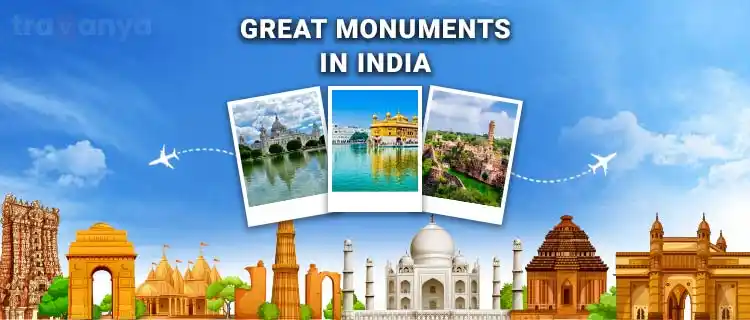
List Of 33 Great Monuments In India To Visit In 2022
Posted on Monday, December 30th, 2024 by Pawanpreet Kaur Leave a Comment
India’s got it all! From its rich heritage and vibrant cultures to stunning architecture and iconic monuments, the country is full of jaw-dropping beauty. One of the biggest reasons India is such a top tourist spot is its treasure trove of ancient monuments and historical sites. Whether you’re a history buff or just love great architecture, you’ll feel at peace walking through these famous landmarks. Here, we’re diving into the must-see monuments of India, each known for its historical or religious significance. So, get ready to soak in some history and culture while planning your next trip! Also, check out our list of India’s famous monuments with names and pictures!
Famous Monuments Of North India
India Gate – National War Memorial
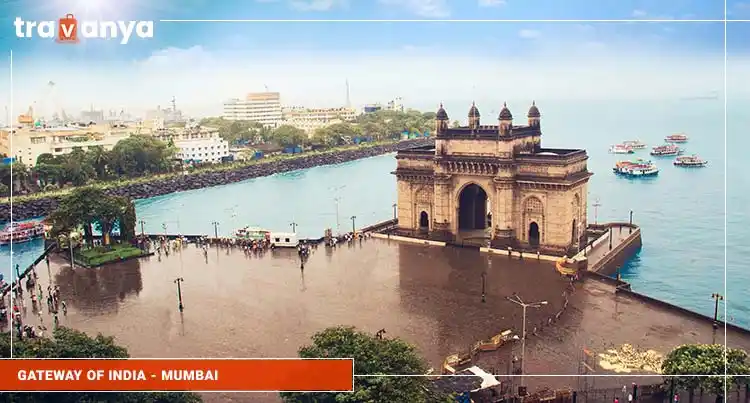
One of the most historic spots in India, India Gate is right in the heart of New Delhi. This national monument honors the 90,000 soldiers who sacrificed their lives defending India between 1914 and 1921. Situated near the Rashtrapati Bhavan, the monument was designed by famous English architect Edwin Lutyens. If you’re in Delhi, you can’t miss this impressive beaux-arts structure. The India Gate also features an eternal flame that has been burning for over 50 years, paying tribute to the soldiers who died in the First World War. So, book your Golden Triangle Tour Package and experience the beauty of India Gate.
- Best Time To Visit: September to March
- Nearby Airport: Indira Gandhi International Airport (IATA: DEL)
- Visiting Hours: 7:00 am – 11:59 pm
- Entry Fee: Free
Taj Mahal – Monument Of Love
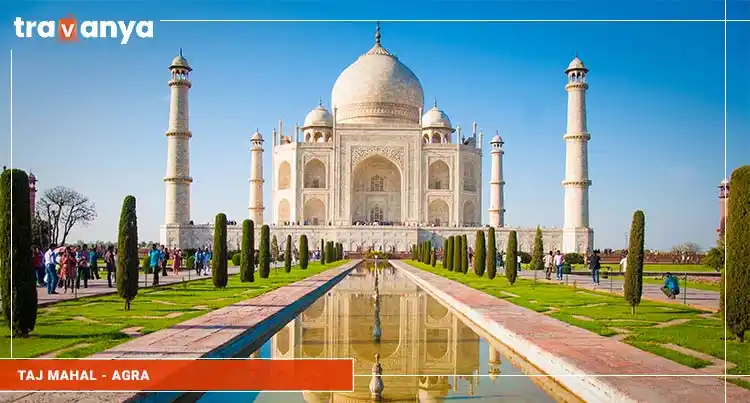
It’s no surprise that the Taj Mahal is a wonder! Known as one of the most beautiful monuments in India, the Taj Mahal is a perfect blend of Persian, Turkish, Indian, and Islamic architectural styles. Located in Agra, this historical site took 22 years to complete, with 20,000 workers and 1,000 elephants involved in its construction. This world-renowned symbol of love was built by Emperor Shah Jahan in 1631 in memory of his beloved wife Mumtaz Mahal. It’s a stunning monument that speaks volumes without saying a word.
- Best Time To Visit: March to June and September to December
- Nearby Airport: Agra Airport (IATA: AGR)
- Visiting Hours: Sunrise to Sunset (Friday Closed)
- Entry Fee: INR 50 (for Indians) and INR 1100 (for foreigners)
Golden Temple – Abode of God
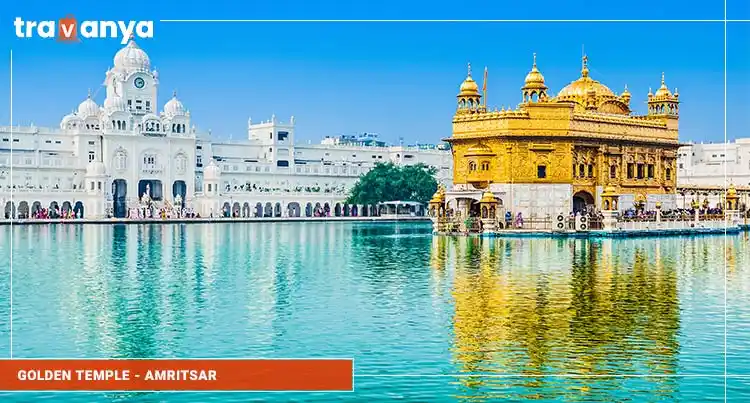
A place of peace and divine presence, the Golden Temple is one of India’s most breathtaking monuments. Located in Amritsar, Punjab, it stands out with its glorious golden architecture and rare beauty. More than a million visitors from around the world come here every year, making it one of the most visited historical monuments in India. Known as “Harmandir Sahib” or “Darbar Sahib,” this sacred place is adored and respected by millions.
- Best Time To Visit: Any time of the year
- Nearby Airport: Amritsar Airport (ATQ)
- Visiting Hours: open 24 hours
- Entry Fee: Free
Jama Masjid – World Reflecting Mosque
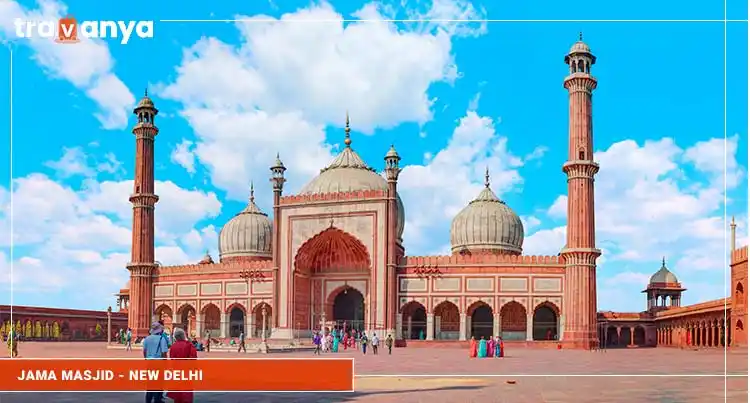
As the largest mosque in India and the tallest single-dome structure in the country, Jama Masjid is a must-see for anyone wanting to connect spiritually. Built by Mughal Emperor Shah Jahan between 1650 and 1656, this massive mosque has an impressive courtyard, beautiful marble structures, and a grand entrance gate. It’s a prime example of Mughal architecture, inspiring countless poets, writers, and artists throughout history.
- Best Time To Visit: During Eid Festival
- Nearby Airport: Indira Gandhi International Airport (IATA: DEL)
- Visiting Hours: 7:00 am to 12:00 pm and 1:30 pm to 6:30 pm
- Entry Fee: Free
Qutub Minar – The Victory Tower
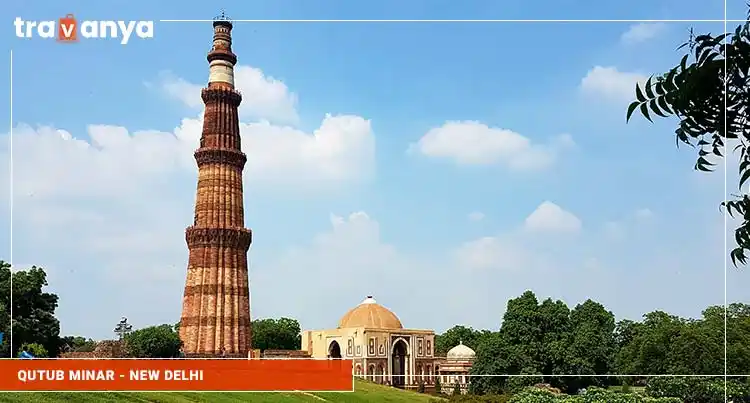
Qutub Minar is the tallest brick minaret in the world, standing at an incredible 238 feet. A stunning example of Indo-Islamic architecture, it was built by Qutub-Ud-Din-Aibak, with construction starting in 1198 and completed in 1215 by the Sultan of Delhi. The tower has gone through many repairs and reconstructions over the years. Today, it’s a UNESCO World Heritage Site, along with the surrounding structures, and remains one of the top monuments to visit in India.
- Best Time To Visit: September to March
- Nearby Airport: Indira Gandhi International Airport (IATA: DEL)
- Visiting Hours: 7:00 am to 5:00 pm
- Entry Fee: INR 35 (for Indians) and INR 550 (for foreigners)
Jaisalmer Fort – The Golden Fort
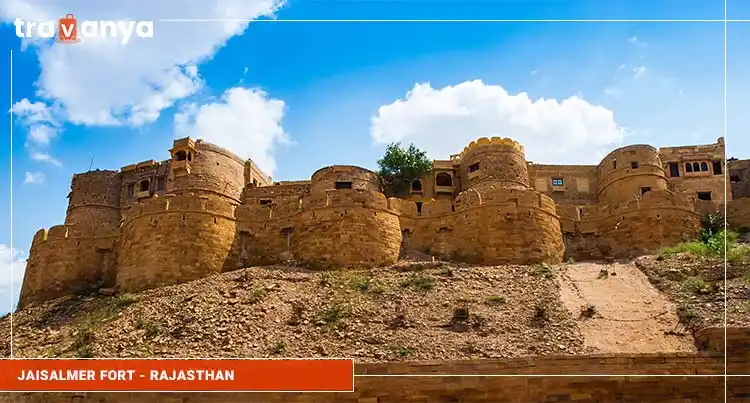
Perched proudly on a 125-meter-high hill, Jaisalmer Fort stands at the heart of Jaisalmer city. Built-in 1156 AD by Rajput Rawal Jaisal, this golden-hued fort looks especially breathtaking at dawn or sunset when it shines like it’s drenched in gold. The fort is about 2 km around and is surrounded by fortifications. Inside, you’ll find shops, restaurants, museums, and hotels, making it an experience worth spending a night or two. So, why not book a Rajasthan Tour Package and include this magnificent fort in your trip?
- Best Time To Visit: October to March
- Nearby Airport: Jodhpur Airport (IATA: JDH)
- Visiting Hours: 9:00 am to 6:00 pm
- Entry Fee: INR 50 (for Indians) and INR 250 (for foreigners)
Amber Fort – The Royal Palace
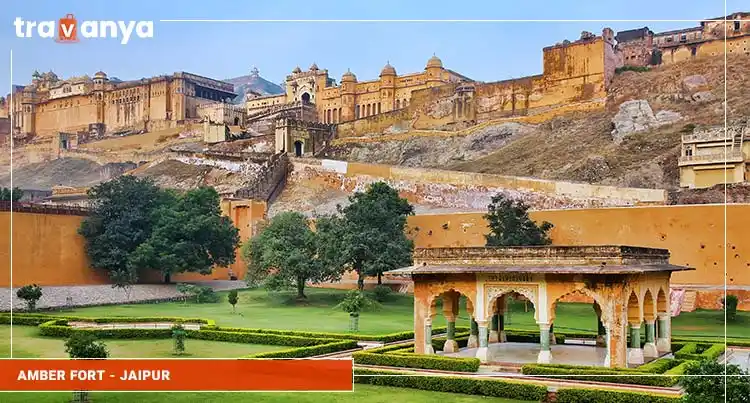
Amber Fort is an amazing example of Rajput architecture and a symbol of Mughal imperial grandeur. Built-in 1592 by Maharaja Man Singh I, it showcases a fusion of military and palace-style architecture. Located just outside Jaipur, this massive fort once served as a base for exploring the western coast of India. If you’re traveling to Jaipur, Amber Fort is a must-see for anyone fascinated by historical palaces.
- Best Time To Visit: October to March
- Nearby Airport: Jaipur International Airport (IATA: JAI)
- Visiting Hours: 8:00 am to 7:00 pm
- Entry Fee: INR 50 (for Indians) and INR 550 (for foreigners)
Hawa Mahal – Palace Of Breeze
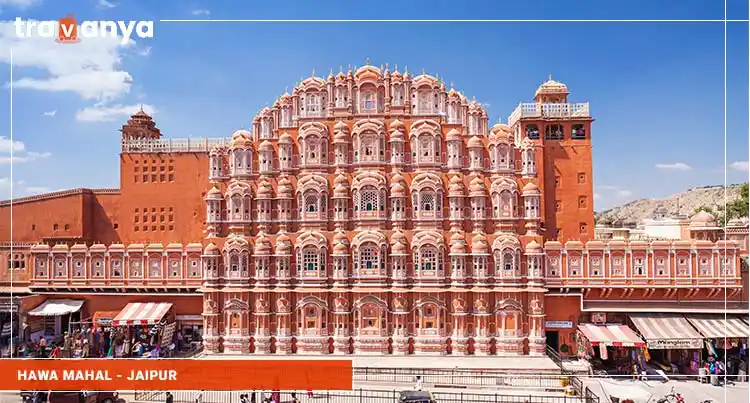
Constructed in the early 18th century by Maharaja Sawai Pratap Singh, Hawa Mahal is a beautiful mix of Mughal and Hindu architectural styles. It’s known for its iconic honeycomb facade with 953 small windows, designed by Lal Chand Ustad in 1799. Located on Hawa Mahal Road, this unique palace was designed for royal women to watch street life from behind its delicate latticework, safe from the public eye.
- Best Time To Visit: October to March
- Nearby Airport: Jaipur International Airport (IATA: JAI)
- Visiting Hours: 9:30 am to 5:00 pm
- Entry Fee: INR 50 (for Indians) and INR 200 (for foreigners)
Mehrangarh Fort – The Majestic Citadel
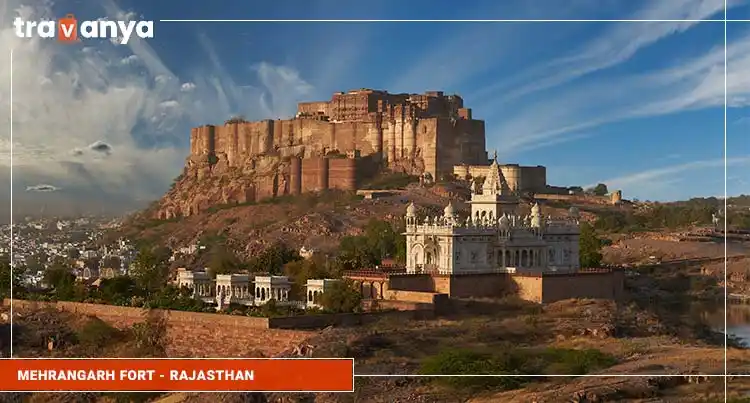
Mehrangarh Fort, one of India’s top 10 historical monuments, is a perfect example of Rajput architecture. Perched on a hill 454 meters above sea level, it stands as one of the most well-preserved forts in India. Built by Jodha of Mandore, this fort has witnessed many significant historical events. It’s definitely a must-visit for anyone interested in history, architecture, and amazing views.
- Best Time To Visit: October to March
- Nearby Airport: Jodhpur Airport (IATA: JDH)
- Visiting Hours: 9:00 am to 5:00 pm
- Entry Fee: INR 100 (for Indians) and INR 600 (for foreigners)
Chittorgarh Fort – The Divine Palace
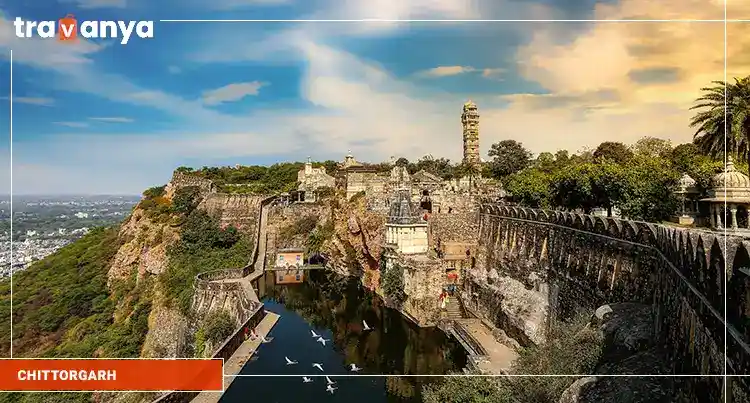
Covering an area of 700 acres, Chittorgarh Fort is one of the largest and most significant heritage sites in India. It’s located near the Bhilwara district of Rajasthan and was built by Chittrangad Maurya, an ancient Mewar ruler. This grand fort is known for its incredible frescoes, stone carvings, and its majestic presence in Rajasthan’s history.
- Best Time To Visit: October to March
- Nearby Airport: Maharana Pratap Airport (IATA: UDR)
- Visiting Hours: 9:30 am to 5:00 pm
- Entry Fee: INR 20 (for adults)
Kumbhalgarh Fort – The Great Wall Of India
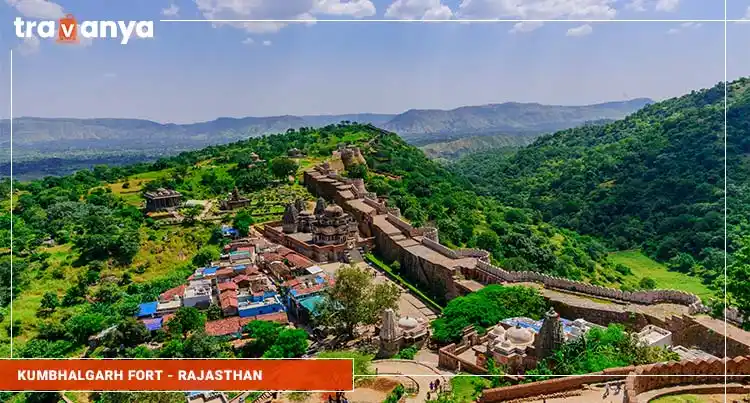
Kumbhalgarh Fort, known for its massive walls, is one of India’s most iconic historical monuments. Built in the 15th century by Rana Kumbha, it’s surrounded by seven hills and spread across 662 acres. Inside, you’ll find numerous Hindu and Jain temples like the Ganesh Temple and Neelkanth Mahadeva Temple, making it a truly spiritual place to visit.
- Best Time To Visit: October to March
- Nearby Airport: Maharana Pratap Airport (IATA: UDR)
- Visiting Hours: 9:00 am to 6:00 pm
- Entry Fee: INR 15 (for Indians) and INR 200 (for foreigners)
Tabo Monastery – Ajanta Of Himalayas
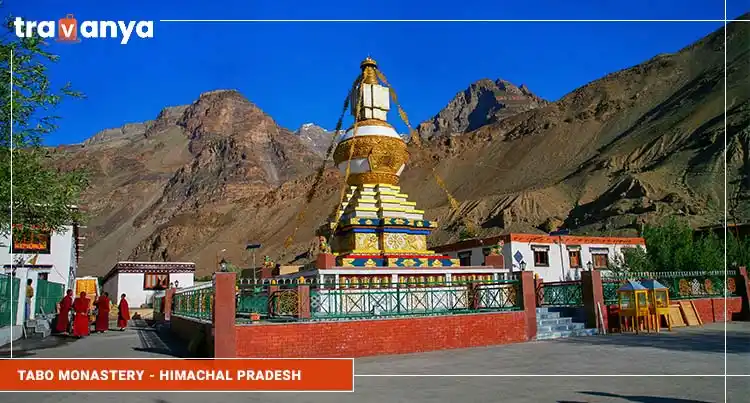
Tabo Monastery is one of the oldest Buddhist monuments in India, dating back to 996 AD. Located in Spiti Valley, it offers a unique spiritual experience with its ancient caves, medieval temples, and modern buildings. The monastery, built by Dharmapala during the reign of King Langdarma, is a peaceful retreat where you can truly connect with the region’s rich Buddhist heritage.
- Best Time To Visit: September and October
- Nearby Airport: Bhuntar Airport (IATA: KUU)
- Visiting Hours: 9:00 am to 5:00 pm
- Entry Fee: Free
Famous Monuments Of South India
Mysore Palace – The King Dynasty
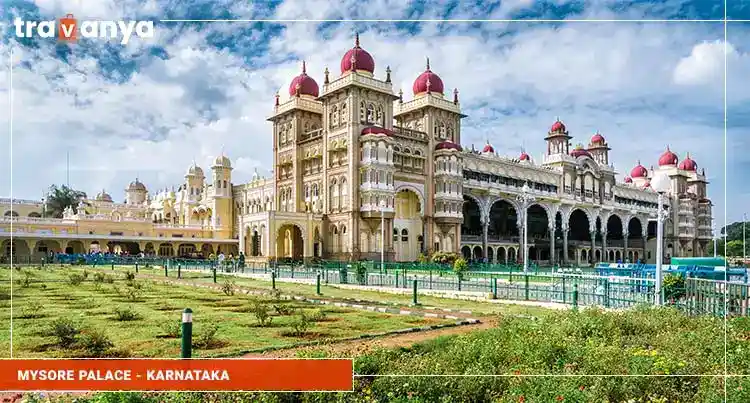
Mysore Palace, located in the southwest of Bangalore, is one of India’s most magnificent palaces. Built by Krishnaraja Wodeyar in 1897, this Indo-Saracenic-style masterpiece stands as a symbol of royal grandeur and rich history. The palace is known for its large iron gates and thick walls, which give it a truly regal look.
- Best Time To Visit: October to April
- Nearby Airport: Mysuru Airport (IATA: MYQ)
- Visiting Hours: 10:00 am to 5:30 pm
- Entry Fee: INR 40 (for Indians) and INR 200 (for foreigners)
Virupaksha Temple – The Home Of Lord Shiva
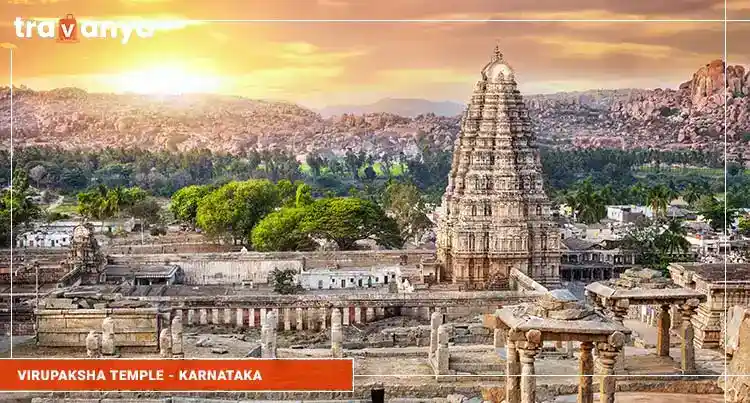
Virupaksha Temple, located in Hampi, is a sacred Hindu temple dedicated to Lord Shiva. It’s one of the best examples of Hoysala architecture and spreads over 32 acres. Built by Queen Lokamahadevi, it is a UNESCO-recognized heritage site that also showcases the beauty of South Indian temple architecture.
- Best Time To Visit: October to February
- Nearby Airport: Bellary Airport (IATA: BEP)
- Visiting Hours: 9:00 am to 1:00 pm, and 5:00 pm to 9:00 pm
- Entry Fee: Free
Belur – The Unforgettable Paradise
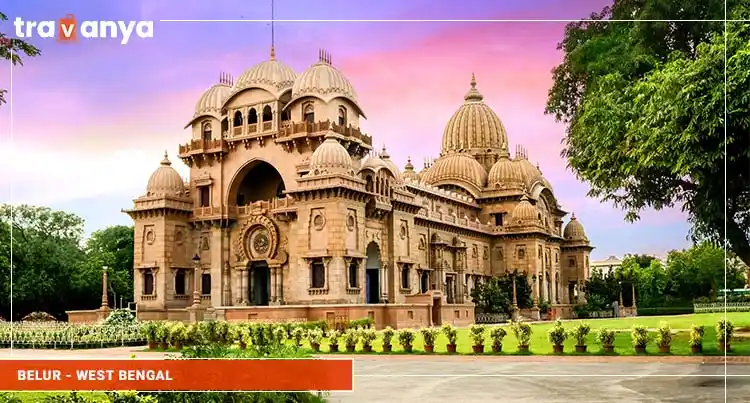
Belur, a small town in Karnataka, is famous for its temples built in the Hoysala architectural style. The town, once called Velapuri, is known for its exquisite temples, especially the Chennakesava Temple. It’s often called the “forgotten paradise” and is one of the hidden gems of South India’s rich history.
- Best Time To Visit: October to December
- Nearby Airport: Kempegowda International Airport (IATA: BLR)
- Visiting Hours: 8:00 am to 11:00 am, and 4:00 pm to 6:00 pm
- Entry Fee: Free
Gol Gumbaz – Taj Mahal Of South India
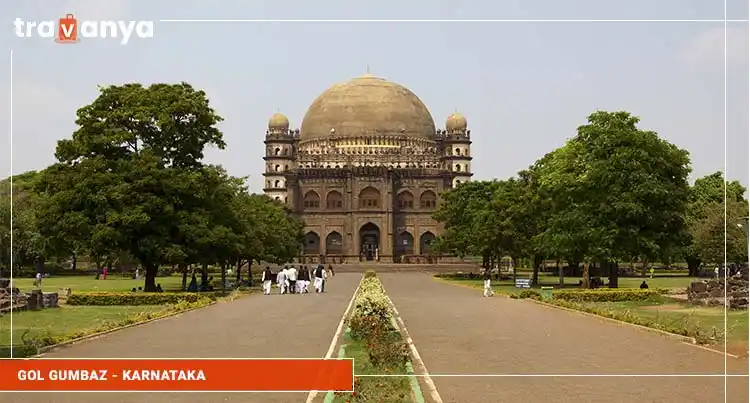
Gol Gumbaz, located in Bijapur, Karnataka, is famous for its massive dome, which is the largest in India. Built by Sultan Muhammad Adil Shah, it stands at an impressive 57 meters and has an acoustically unique design. It is often compared to the Jama Masjid in Delhi, thanks to its grandeur and historical importance.
- Best Time To Visit: November to early-March
- Nearby Airport: Belgaum Airport (IATA: IXG)
- Visiting Hours: 10:00 am to 5:00 pm
- Entry Fee: INR 20 (for Indians) and INR 200 (for foreigners)
Charminar – Famous Four Minarets
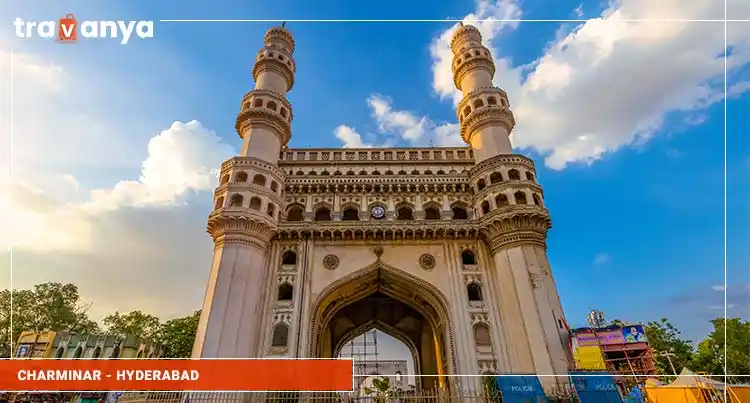
Charminar, located in Hyderabad, is a significant historical monument with a rich cultural past. Built by Muhammad Quli Qutb Shah in 1591, it’s famous for its four minarets and grand central arch. The structure stands as a symbol of Hyderabad’s legacy and attracts millions of tourists each year.
- Best Time To Visit: October to March
- Nearby Airport: Rajiv Gandhi International Airport (IATA: HYD)
- Visiting Hours: 9:30 am to 5:30 pm
- Entry Fee: INR 20 (for Indians) and INR 250 (for foreigners)
Warangal Fort – The Historical Pillars
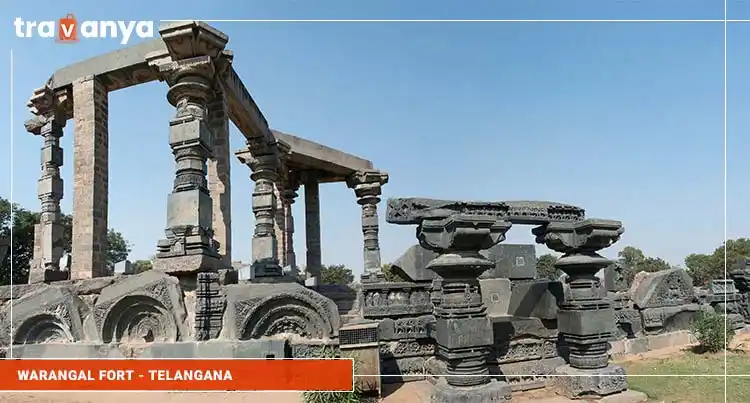
Warangal Fort, built in the 13th century by King Ganapati Deva, is a blend of Hindu and Muslim traditions, representing the epitome of defense architecture. The fort’s unique design reflects the Vijayanagara style at the top and Islamic influence at the base. It offers insight into India’s diverse architectural heritage.
- Best Time To Visit: October to March
- Nearby Airport: Rajiv Gandhi International Airport (IATA: HYD)
- Visiting Hours: 10:00 am to 7:00 pm
- Entry Fee: INR 25 (for Indians) and INR 300 (for foreigners)
Vivekananda Rock Memorial – The Meditational Rock
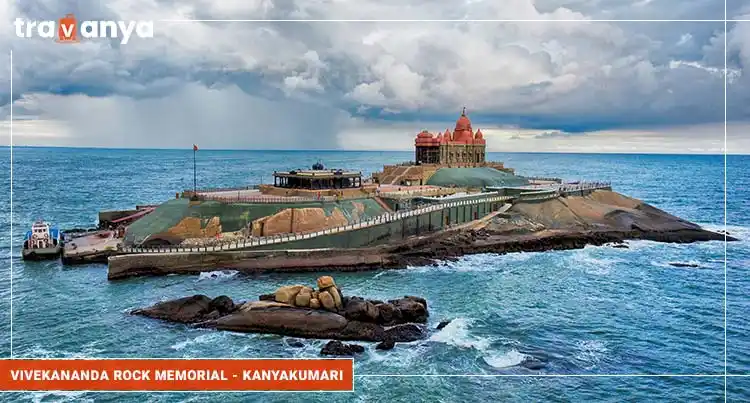
Vivekananda Rock Memorial, located in Kanyakumari, is a UNESCO world heritage site built in 1970 to commemorate Swami Vivekananda. The site was previously known as Pancha Pandava Guha and is believed to be the place where the Pandavas hid their weapons. It’s a place of spiritual significance and offers breathtaking views of the surrounding sea.
- Best Time To Visit: October to March
- Nearby Airport: Chennai International Airport (IATA: MAA)
- Visiting Hours: 7:00 am to 5:00 pm
- Entry Fee: INR 20 (for adults)
Group of Monuments at Mahabalipuram – The Seven Raths
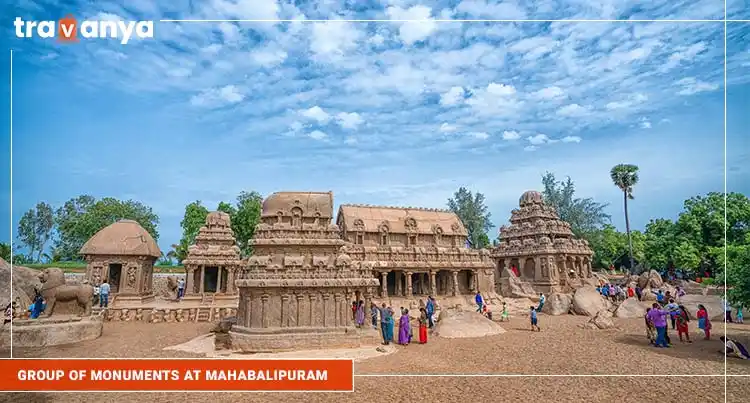
Mahabalipuram, home to the UNESCO World Heritage-listed group of monuments, is famous for its rock-cut temples and shrines. Built during the reign of Pallava king Narasimha Varman I in the 7th century, the monuments represent a rich mix of Shaivism and Vaishnavism architecture. The iconic Seven Raths or Seven Pagodas are a must-see.
- Best Time To Visit: October to March
- Nearby Airport: Chennai International Airport (IATA: MAA)
- Visiting Hours: 6:00 am to 6:00 pm
- Entry Fee: INR 10 (for Indians) and INR 340 (for foreigners)
Kapaleeshwarar Temple – Wish Come True Temple
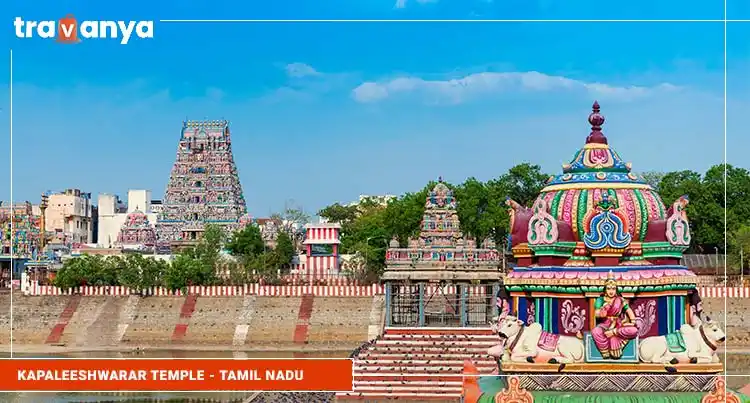
Kapaleeshwarar Temple in Chennai, built in the 7th century during the Pallava dynasty, is a stunning example of Dravidian architecture. Dedicated to Lord Shiva, it’s one of the most visited temples in the region, especially during festivals. The intricate carvings and vast shrines make it a peaceful and awe-inspiring place to visit.
- Best Time To Visit: September to March
- Nearby Airport: Chennai International Airport (IATA: MAA)
- Visiting Hours: 5:00 am to 12:00 pm, and 4:00 pm to 9:30 pm
- Entry Fee: Free
Famous Monuments Of West India
Ajanta Caves – Ancient Worship Halls
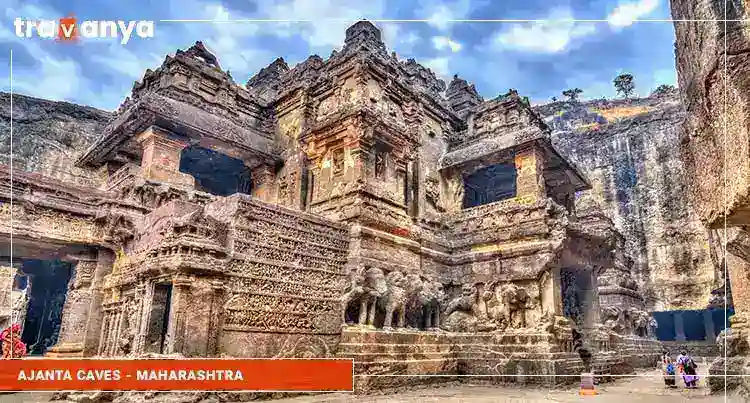
The Ajanta Caves, located in Maharashtra’s Aurangabad district, are one of India’s most famous ancient monuments. These caves, which were carved between the 2nd and 7th centuries AD, are a UNESCO World Heritage Site and are known for their stunning Buddhist artwork. There are around 30 caves, each decorated with beautiful paintings and carvings that tell stories from ancient Indian traditions and beliefs. The Ajanta Caves are a true reflection of India’s cultural and religious history, and they’re a must-visit for anyone wanting to learn more about the past.
- Best Time To Visit: March to June, and October to January
- Nearby Airport: Aurangabad Airport (IATA: IXU)
- Visiting Hours: 9:00 am to 5:00 pm
- Entry Fee: Free (for Indians) and INR 250 (for foreigners)
Ellora Caves – Sacred Cave Temples
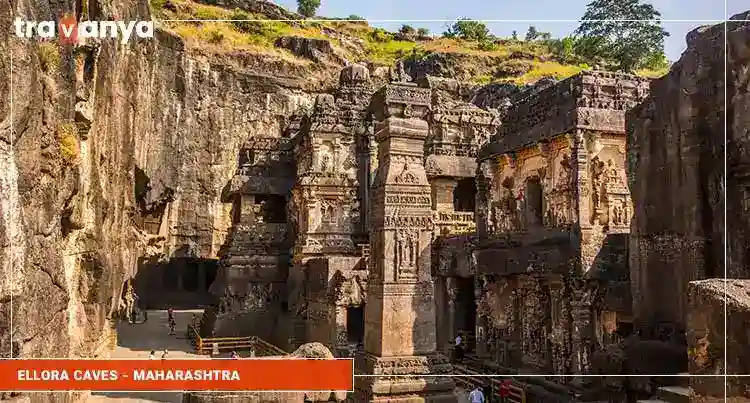
If you’re a fan of history and architecture, the Ellora Caves are a place you can’t miss. Located in the Aurangabad district of Maharashtra, these caves are one of the largest rock-cut temple complexes in the world. Built between the 2nd century BC and the 12th century AD, the Ellora Caves feature a blend of Hindu, Buddhist, and Jain temples, all carved out of massive volcanic rock. The intricate sculptures and carvings are amazing, and the site gives you a glimpse into ancient Indian society and religious practices.
- Best Time To Visit: March to June, and October to January
- Nearby Airport: Aurangabad Airport (IATA: IXU)
- Visiting Hours: 8:00 am to 5:30 pm
- Entry Fee: INR 40 (for Indians) and INR 600 (for foreigners)
Chhatrapati Shivaji Terminus – Victoria Terminus Station
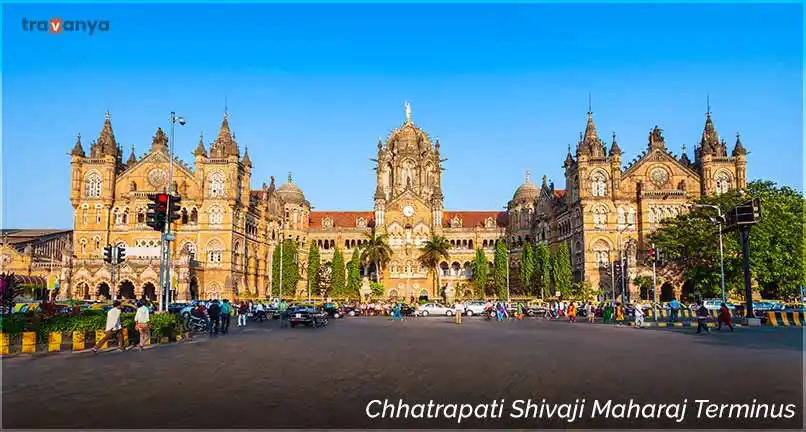
Chhatrapati Shivaji Terminus in Mumbai is one of the busiest railway stations in India and an important historical landmark. It was originally known as Victoria Terminus and was built in 1888. Designed by British architects, this station combines Victorian Gothic style with traditional Indian architectural elements. It was made to honor the Maratha king Chhatrapati Shivaji and is a UNESCO World Heritage Site. The station is famous for its grand architecture, making it a must-see for visitors to Mumbai.
- Best Time To Visit: October to December
- Nearby Airport: Chhatrapati Shivaji Maharaj International Airport (IATA: BOM)
- Visiting Hours: 24 hours a day
- Entry Fee: Free
Gateway Of India – Taj Mahal Of Mumbai
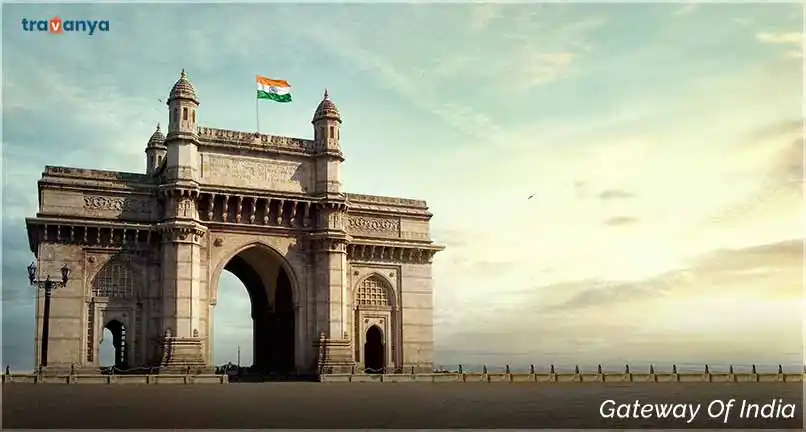
The Gateway of India is one of Mumbai’s most iconic landmarks. Built to celebrate the visit of King George V and Queen Mary in 1911, the Gateway is a stunning blend of Hindu and Muslim architectural styles. Located by the waterfront, it faces the Arabian Sea and is a symbol of India’s welcoming spirit. It’s not only a popular tourist spot but also an important part of Mumbai’s history, marking the end of British rule in India when the last British troops passed through it in 1948.
- Best Time To Visit: September to March
- Nearby Airport: Chhatrapati Shivaji Maharaj International Airport (IATA: BOM)
- Visiting Hours: 24 hours a day
- Entry Fee: Free
Elephanta Caves – Caves Of The Thousand Buddhas
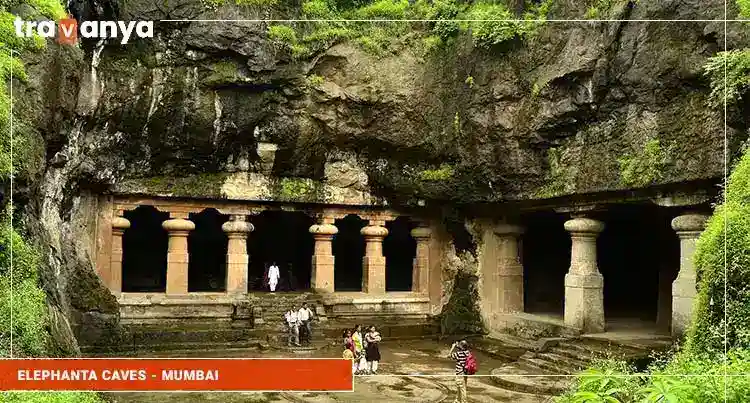
Elephanta Caves, located on Elephanta Island about 12 km from Mumbai, are an important historical site dedicated to Lord Shiva. These caves, which were built between the 5th and 8th centuries, are known for their amazing rock-cut temples and sculptures. The Elephanta Caves are sometimes referred to as the “Caves of the Thousand Buddhas” due to the many Buddha statues and carvings found inside. Visitors can also explore another set of 5th-century Buddhist caves known as the Kanheri Caves. It’s a peaceful and spiritual place to spend a few hours, just a short ferry ride from the city.
- Best Time To Visit: November to February
- Nearby Airport: Chhatrapati Shivaji Maharaj International Airport (IATA: BOM)
- Visiting Hours: 9:30 am to 5:30 pm
- Entry Fee: INR 40 (for Indians) and INR 600 (for foreigners)
Laxmi Vilas Palace – The Viceroy Lodge
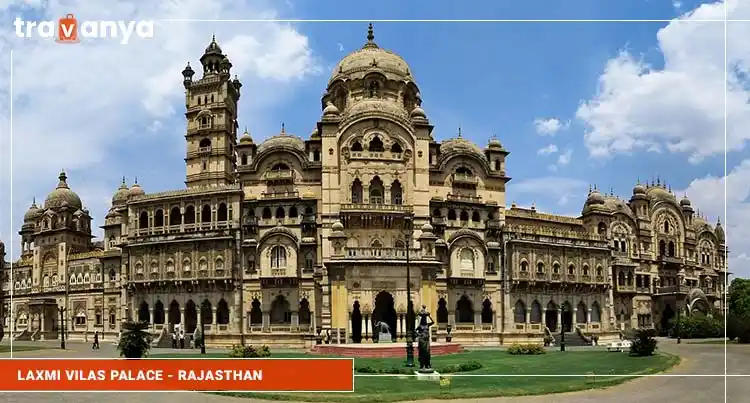
Laxmi Vilas Palace, also known as the Viceroy Lodge, is a beautiful palace in Gwalior that showcases a mix of Indian, Rajput, and European architectural styles. Built in the late 1800s by Maharaja Ganga Singh, the palace was originally constructed as a royal residence and later became a symbol of the grandeur of royal life. The palace is a great example of opulent Maharaja living and is one of the best-preserved monuments from the British Raj. If you’re into history and architecture, this is a place to see!
- Best Time To Visit: October to December
- Nearby Airport: Vadodara Airport (IATA: BDQ)
- Visiting Hours: 10:00 am to 4:30 pm
- Entry Fee: INR 225 (for Indians) and INR 400 (for foreigners)
Dwarkadhish Temple – Ancient Monument Of India
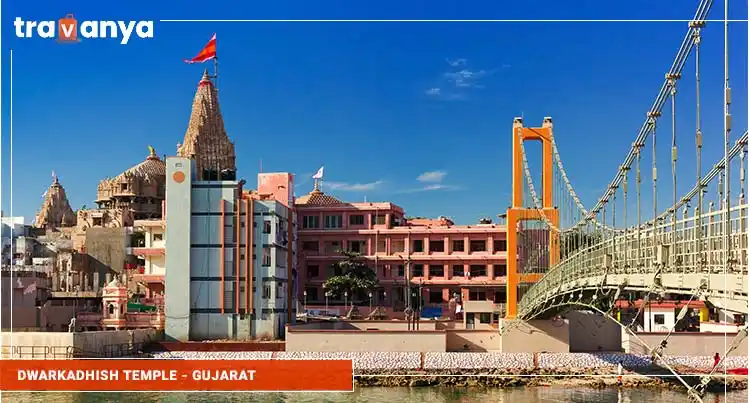
The Dwarkadhish Temple in Dwarka, Gujarat, is one of the oldest and most significant temples in India. This temple is dedicated to Lord Krishna and has a history that dates back over 5000 years. The temple stands on the banks of the Bay of Bengal and is an important pilgrimage site for Hindus. It’s also known as “Jagat Mandir” and is considered a symbol of divine love and devotion. The peaceful atmosphere and beautiful architecture make it a must-visit spot in Gujarat.
- Best Time To Visit: September to December
- Nearby Airport: Porbandar Airport (IATA: PBD)
- Visiting Hours: 8:00 am to 8:00 pm
- Entry Fee: Free
Basilica of Bom Jesus – House of Jesus
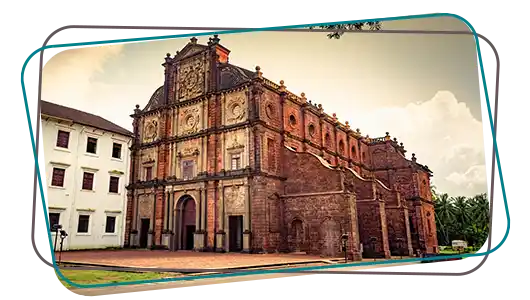
Located in Goa, the Basilica of Bom Jesus is one of India’s most famous historical monuments and an important religious site. The basilica is dedicated to St. Francis Xavier, whose body is preserved inside the church, making it a popular pilgrimage site for Christians. The church’s beautiful baroque architecture and rich history attract both domestic and international visitors. It’s a place where art, history, and faith come together, making it a must-see in Goa.
- Best Time To Visit: September to March
- Nearby Airport: Goa Airport (IATA: GOI)
- Visiting Hours: 9:00 am to 6:30 pm (on weekdays), and 10:30 am to 6:30 pm (Sunday)
- Entry Fee: Free
Famous Monuments Of East India
Konark Temple – The Black Pagoda
The Konark Sun Temple, also known as the Black Pagoda, is one of the most famous and impressive monuments in India. Built by King Narasimhadeva I of the Ganga dynasty, the temple was originally a grand structure dedicated to the Sun God, Surya. Over the years, it was damaged by Mughal invaders and lay in ruins until 1811 when Lord Lake organized its restoration. The temple’s unique design is a masterpiece of Indian temple architecture, with intricate sculptures and Sanskrit inscriptions on its walls representing various Hindu gods like Surya, Vishnu, Shiva, and Parvati. The temple is set on an earthen platform, which you reach by a flight of steps.
- Best Time To Visit: September to March
- Nearby Airport: Bhubaneswar Airport (IATA: BBI)
- Visiting Hours: 10:00 am to 5:00 pm
- Entry Fee: INR 40 (for Indians) and INR 600 (for foreigners)
Dubdi Monastery – The Lost Continent of North East
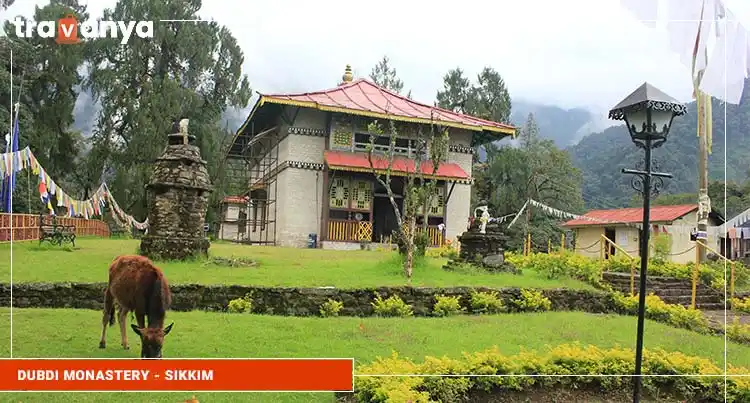
Dubdi Monastery is an important Buddhist site in the northeast of India. It is located in Assam, near the village of Dubdi, perched majestically on a small hill. Known as “The Lost Continent,” this monastery holds great significance and was even visited by the Dalai Lama during his first trip to Sikkim in 1983. It is believed to have been built in the 11th century by a Tibetan Lama, though there is no solid historical evidence to support this claim. Dubdi Monastery offers a peaceful and spiritual environment and is an ideal place for those interested in the region’s Buddhist history.
- Best Time To Visit: March to May
- Nearby Airport: Guwahati Airpot (IATA: GAU)
- Visiting Hours: 7:00 am to 4:00 pm
- Entry Fee: INR 20
Victoria Memorial – Epitome Of Kolkata
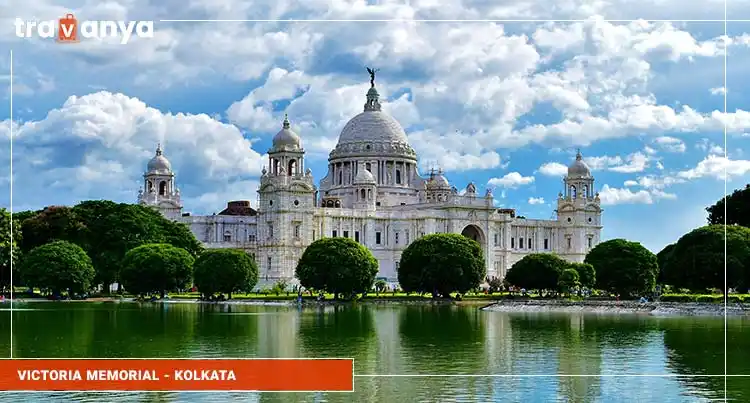
The Victoria Memorial is one of the most grand and beautiful landmarks in Kolkata. Located near the famous Howrah Bridge, this majestic white marble building was constructed in the early 20th century to honor Queen Victoria. Inaugurated by King George V, it stands as a symbol of the British colonial era. Over 3000 craftsmen worked for several years to build this magnificent structure, which combines white marble with red sandstone and grey basalt. The memorial is now a museum, showcasing various collections of art and historical items related to India’s British history.
- Best Time To Visit: October to March
- Nearby Airport: Netaji Subhas Chandra Bose International Airport (IATA: CCU)
- Visiting Hours: 10:00 am to 5:00 pm (for gallery) 5:30 pm to 6:15 pm (gardens)
- Entry Fee: INR 20 (for Indians) and INR 200 (for foreigners)
Howrah Bridge – The Iconic Bridge
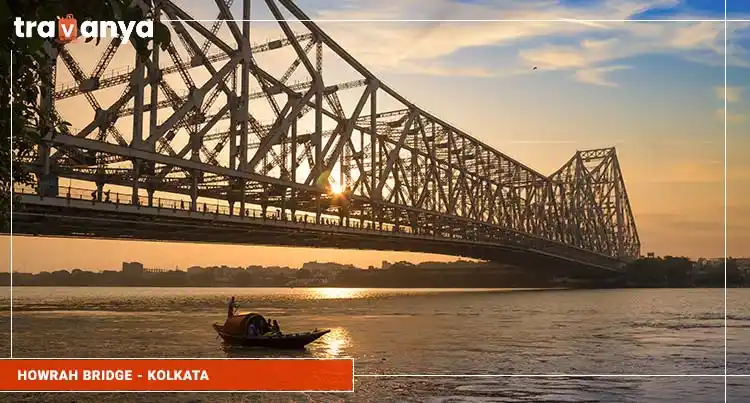
Howrah Bridge, also known as Rabindra Setu, is one of the busiest and most iconic bridges in India. Located in Kolkata, it’s not just a functional bridge but also a symbol of the city’s rich history and culture. Designed by English engineer Sir Bradford Leslie, the bridge took about 10 years to complete. Its unique design and massive structure make it a popular landmark, and it’s now a key part of the city’s infrastructure, connecting Howrah to the rest of Kolkata. It’s also one of the most photographed spots in the city.
- Best Time To Visit: October to February
- Nearby Airport: Netaji Subhas Chandra Bose International Airport (IATA: CCU)
- Visiting Hours: 24 hours a day
- Entry Fee: Free
Monuments in India are celebrated for their incredible architecture and the rich history they represent. We hope this list of famous Indian monuments was helpful to you! If you’re looking for more information about historical places to visit in India, reach out to our travel professionals at +91-869-999-5345 or email us at info@travanya.com.
Our experts at Travanya, a leading travel agency, can help you plan affordable Holiday Packages to the location of your dreams. Ready to check out India’s stunning monuments? Contact us today and start your journey!
If you’re looking to explore beyond India, we also offer affordable international tour packages to suit any budget or purpose.
Frequently Asked Questions
Ques: Which monuments are built by the British in India?
Answer: Some of the prominent monuments built by the British in India include the India Gate in Delhi, The Parliament House in Delhi, the Gateway of India in Mumbai, and the Victoria Memorial in Kolkata.
Ques: What is the oldest monument in India?
Answer: The Ajanta Caves in Maharashtra are considered the oldest monuments in India, with their origins dating back to around the 2nd century BC.
Ques: How many monuments are there in India?
Answer: India is home to a vast number of monuments. The Archaeological Survey of India has ticketed 116 monuments across 19 states. Some of the top 5 famous monuments in India include India Gate, Taj Mahal, Gateway of India, Red Fort, and Konark Sun Temple.
Ques: What is the tallest monument of India?
Answer: The Qutub Minar in Delhi holds the title as the tallest monument in India. While many people refer to the Statue of Unity as the tallest monument, it is technically the tallest statue in India.
About Pawanpreet View All Posts
Pawanpreet is a versatile content writer and editor who enjoys experimenting with various niches of writing. Her keen eye for detail and love for thorough research helps her create high-quality content to outweigh clickbait. She extensively works for digital marketing and manages clients that range from travel to luxury goods. Her creativity is fueled by her love for learning new things, travelling, and the environment. Also, she is a free soul and an avid animal lover who believes in doing everything with a smile :)



Leave a Comment